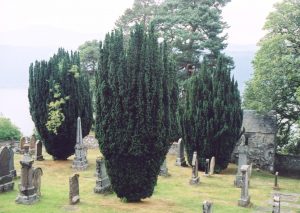 With many of the leaves gone from the trees the yew trees are now conspicuous and take on a grandeur of their own. There are few trees in the Highlands that are so mysterious and with a rich history of folk lore and myths. They have attracted writers, artists and poets for centuries and so much so that a number of monographs have been written about them. By far my favourite is “Yew – A History” by Fred Hageneder as it covers so much of this ancient tree’s uses from the making of longbows to the poetry and the dating of old yews to a potential poison. Another fine monograph is “The Eternal Yew” – how apt a title, by Trevor Baxter. The age of yew trees has always been part of its mystery particularly as one yew – the Fortingale Yew in the grounds of the Kirk at Fortingale, a Perthshire village at the entrance to the romantic Glen Lyon, is reputed to be the oldest tree in Europe. The estimates for the age of this famous yew are between 1500 and 3000 years and they are based on the girth of between 52 and 56 feet, but, unfortunately, only fragments of the girth survived.
With many of the leaves gone from the trees the yew trees are now conspicuous and take on a grandeur of their own. There are few trees in the Highlands that are so mysterious and with a rich history of folk lore and myths. They have attracted writers, artists and poets for centuries and so much so that a number of monographs have been written about them. By far my favourite is “Yew – A History” by Fred Hageneder as it covers so much of this ancient tree’s uses from the making of longbows to the poetry and the dating of old yews to a potential poison. Another fine monograph is “The Eternal Yew” – how apt a title, by Trevor Baxter. The age of yew trees has always been part of its mystery particularly as one yew – the Fortingale Yew in the grounds of the Kirk at Fortingale, a Perthshire village at the entrance to the romantic Glen Lyon, is reputed to be the oldest tree in Europe. The estimates for the age of this famous yew are between 1500 and 3000 years and they are based on the girth of between 52 and 56 feet, but, unfortunately, only fragments of the girth survived.
However, the Fortingale yew now has a rival as there is a yew in Wales, at Defynnog, that is reputed to be 5,000 years old. However, you do not have to travel that far to see an old yew as in the Highlands there is one at Dundonnel south west of Ullapool although compared with others it is a mere, estimated, 2,000 years old. The gardens are open for some days during the year and I well remember the last time I went there. After paying the modest entrance fee I asked “where is the tree” and they knew straight away which one I wanted to see. It is a very impressive tree so why not visit it next summer when the garden is open again? Closer to Inverness is where I took the photograph of the superb looking yew trees in Bolingbroke Burial Ground near Foyers. The shape of yew trees varies depending on their age as it is broadly conical when they are younger. Then the older it gets the more columnar it becomes as the branches grow outward as quickly as the height grows. That is why the Boleskine ones are that delightful columnar profile. The added advantage of these yews is that the churchyard is on the side of Loch Ness so there is always the chance of seeing the Loch Ness Monster!
You cannot think about yew trees without thinking about the famous longbows. The best wood for the bows is, by far, the yew followed by wych elm. In the north, Including the Highlands, the alternatives that were used were the ash, hazel, fir or oak. The advantage of the yew was that it could be cut so that it contained both sapwood, to give springiness, and heartwood, for the sheer strength. The problem was that there were just not enough yew trees to meet the demand for archers in the UK. So the problem was overcome by importing very large quantities of timber from the continent , mainly from Spain. There was an added bonus with using yew that is often overlooked but it was very important. The seeds of yew yielded a deadly poison and it was use to tip the arrowheads.
Tags: highland flora
